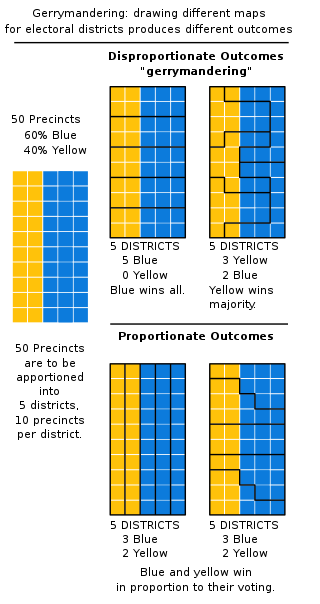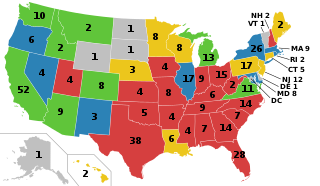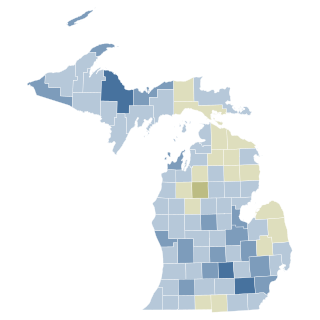
In representative democracies, gerrymandering is the political manipulation of electoral district boundaries with the intent to create undue advantage for a party, group, or socioeconomic class within the constituency. The manipulation may involve "cracking" or "packing". Gerrymandering can also be used to protect incumbents. Wayne Dawkins describes it as politicians picking their voters instead of voters picking their politicians.
Redistricting in the United States is the process of drawing electoral district boundaries. For the United States House of Representatives, and state legislatures, redistricting occurs after each decennial census.

North Carolina is currently divided into 14 congressional districts, each represented by a member of the United States House of Representatives. After the 2000 census, the number of North Carolina's seats was increased from 12 to 13 due to the state's increase in population. In the 2022 elections, per the 2020 United States census, North Carolina gained one new congressional seat for a total of 14.
Congressional districts, also known as electoral districts and legislative districts, electorates, or wards in other nations, are divisions of a larger administrative region that represent the population of a region in the larger congressional body. Notably, Australia's districts are referred to as electorates or seats; in Canada, these are called "constituencies", or more informally "ridings". Countries with congressional districts include the United States, the Philippines, and Japan.

California is the most populous U.S. state; as a result, it has the most representation in the United States House of Representatives, with 52 Representatives. Each Representative represents one congressional district.

Virginia is currently divided into 11 congressional districts, each represented by a member of the United States House of Representatives. The death of Rep. Donald McEachin on November 28, 2022, left the 4th congressional district seat empty. Following the results of a special election to fill his seat on February 21, 2023, Jennifer McClellan made history by becoming Virginia's first black congresswoman.

In the United States, a redistricting commission is a body, other than the usual state legislative bodies, established to draw electoral district boundaries. Generally the intent is to avoid gerrymandering, or at least the appearance of gerrymandering, by specifying a nonpartisan or bipartisan body to comprise the commission drawing district boundaries.

Redistricting in Pennsylvania refers to the decennial process of redrawing state legislative and federal congressional districts in Pennsylvania.

Gerrymandering is the practice of setting boundaries of electoral districts to favor specific political interests within legislative bodies, often resulting in districts with convoluted, winding boundaries rather than compact areas. The term "gerrymandering" was coined after a review of Massachusetts's redistricting maps of 1812 set by Governor Elbridge Gerry noted that one of the districts looked like a mythical salamander.

The 2020 United States redistricting cycle is in progress following the completion of the 2020 United States census. In all fifty states, various bodies are re-drawing state legislative districts. States that are apportioned more than one seat in the United States House of Representatives are also drawing new districts for that legislative body.
Gill v. Whitford, 585 U.S. ___ (2018), was a United States Supreme Court case involving the constitutionality of partisan gerrymandering. Other forms of gerrymandering based on racial or ethnic grounds had been deemed unconstitutional, and while the Supreme Court had identified that extreme partisan gerrymandering could also be unconstitutional, the Court had not agreed on how this could be defined, leaving the question to lower courts to decide. That issue was later resolved in Rucho v. Common Cause, in which the Court decided that partisan gerrymanders presented a nonjusticiable political question.
REDMAP is a project of the Republican State Leadership Committee of the United States to increase Republican control of congressional seats as well as state legislatures, largely through determination of electoral district boundaries. The project has made effective use of partisan gerrymandering, by relying on previously unavailable mapping software such as Maptitude to improve the precision with which district lines are strategically drawn. The strategy was focused on swing blue states like Pennsylvania, Ohio, Michigan, North Carolina, and Wisconsin where there was a Democratic majority but which they could swing towards Republican with appropriate redistricting. The project was launched in 2010 and estimated to have cost the Republican party around US$30 million.
Benisek v. Lamone, 585 U.S. ____ (2018), and Lamone v. Benisek, 588 U.S. ____ (2019), were a pair of decisions by the Supreme Court of the United States in a case dealing with the topic of partisan gerrymandering arising from the 2011 Democratic party-favored redistricting of Maryland. At the center of the cases was Maryland's 6th district which historically favored Republicans and which was redrawn in 2011 to shift the political majority to become Democratic via vote dilution. Affected voters filed suit, stating that the redistricting violated their right of representation under Article One, Section Two of the U.S. Constitution and freedom of association of the First Amendment.
Abbott v. Perez, 585 U.S. ___ (2018), was a United States Supreme Court case dealing with the redistricting of the state of Texas following the 2010 Census.
Rucho v. Common Cause, No. 18-422, 588 U.S. ___ (2019) is a landmark case of the United States Supreme Court concerning partisan gerrymandering. The Court ruled that while partisan gerrymandering may be "incompatible with democratic principles", the federal courts cannot review such allegations, as they present nonjusticiable political questions outside the remit of these courts.
Thomas Brooks Hofeller was a Republican political strategist primarily known for his involvement in gerrymandering electoral district maps favorable for Republicans. David Daley of The New Yorker referred to Hofeller as "the master of the modern gerrymander." According to The New York Times, Hofeller's "mastery of redistricting strategy helped propel the Republican Party from underdog to the dominant force in state legislatures and the United States House of Representatives."

Redistricting in North Carolina has been a controversial topic due to allegations and admissions of gerrymandering.

Michigan Proposal 18-2 was a ballot initiative approved by voters in Michigan as part of the 2018 United States elections. The proposal was created in preparation of the 2020 United States Census, to move control of redistricting from the state legislature to an independent commission. The commission consists of thirteen members selected randomly by the secretary of state: four affiliated with Democrats, four affiliated with Republicans, and five independents. Any Michigan voter can apply to be a commissioner, as long as they have not been, in the last six years, a politician or lobbyist. Proponents argued that Michigan's current districts are gerrymandered, giving an unfair advantage to one political party. Opponents argued that the process would give the secretary of state too much power over redistricting, and that the people on the commission would be unlikely to understand principles of redistricting. The proposal was approved with 61.28% of the vote.

Redistricting in Wisconsin is the process by which boundaries are redrawn for municipal wards, Wisconsin State Assembly districts, Wisconsin State Senate districts, and Wisconsin's congressional districts. Redistricting occurs—as in other U.S. states—once every decade, usually in the year after the decennial United States census. According to the Wisconsin Constitution, redistricting in Wisconsin follows the regular legislative process, it must be passed by both houses of the Wisconsin Legislature and signed by the Governor of Wisconsin—unless the Legislature has sufficient votes to override a gubernatorial veto. Due to legislative gridlock, however, it has become common for Wisconsin redistricting to be conducted by courts. The 1982, 1992, and 2002 legislative maps were each created by panels of United States federal judges.
The 2010 United States redistricting cycle took place following the completion of the 2010 United States census. In all fifty states, various bodies re-drew state legislative districts. States that are apportioned more than one seat in the United States House of Representatives also drew new districts for that legislative body. The resulting new districts were first implemented for the 2011 and 2012 elections.













